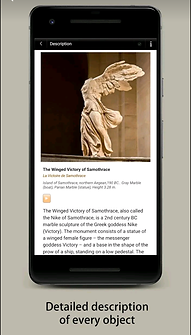UX Designer
.png)
METHODS
TOOLS
Mia Audio
A personalized, self-guided audio tour that helps users learn more about what's interesting to them.
October - December 2021
Overview
I developed a new product concept and prototype for the mobile application, Mia Audio — a solution intended to fill an opportunity area for inclusivity and accessibility for all patrons of Minneapolis' art gallery.
KEY DELIVERABLES
PROCESS WORK
MY ROLE
UX Researcher, UX/UI Designer, User Interview & Usability Testing Moderator
User Interviews, Competitive & Comparative Audit, Value Opportunity Analysis, Task Analysis, Affinity Diagramming, User Stories, Task & User Flows, Screen Flows, Low-Fidelity Prototyping, High-Fidelity Interactive Prototyping, Usability Testing, Design Systems & UI Kits, Style Guides
Figma, Zoom, Google Sheets, Google Docs, Google Slides, Pen & Paper
SUMMARY
Key Points
-
Problem: Develop a new product concept within the problem space of self-guided audio tours at a local museum, with a particular focus on accessibility and inclusivity.
-
Process: Working as a 1-person team, I evaluated the existing experience using internal (competitive/comparative audit, value opportunity analysis) and user-focused methods in order to identify painpoints and attitudes to direct the development of user goal statements and stories.
-
Findings: There was an opportunity in the market for a self-guided tour at local museums because none in the Twin Cities currently offer that service.
-
Solution: Working from a starting point of with lo-fi sketches, I developed a digital wireframes, conducted user testing (usability testing), in order to inform revisions in a hi-fi interactive prototype.
-
Reflection: This project provided the opportunity to build a way for everyone to access more information about art at the museum. I learned just how important a diverse audience is in usability testing. Certain tasks that are easy for some demographics are next to impossible for others. In the future, I will continue to recruit from a diverse pool of users for testing.
THE PROBLEM
Problem Statement
Users want to learn more about the art and artists, but don’t have the time or interest to go through a long, docent-guided tour. Users want to learn more about specific pieces that compel them. They also still want to feel like they’re a part of the museum—hearing people’s whispers and laughter.
Goal Statement
Create an audio tour app for the Minneapolis Institute of Art, where users can scan QR codes to learn more about the piece that interest them.
Understanding the Existing User Experience
To gain a more complete understanding of the problem space, market landscape, and user needs, I conducted a competitive audit, including both direct and indirect competitors.

A competitive audit was conducted on key museum audio tours: the Louvre, Stonehenge, Smithsonian Fossil Exhibit, Milwaukee Public Museum, bell museum, Walker Art Center, and Minneapolis Institute of Art.

Minneapolis Institute of Art Audio Tour

Rijksmuseum Audio Tour

Stonehenge Audio Tour

The Louvre Audio Tour
UNDERSTANDING THE USER
User Research
I conducted interviews and created empathy maps to better understand my user’s needs and desires. A primary user group identified through the research was extroverted adults who were first-time exhibit goers who wanted to learn more about the art and their creators.
The research challenged assumptions about the Art in Bloom exhibit and revealed that being a part of the museum, like hearing the din of the crowd, is important to the user, as is the ability to move through it independently, selecting only pieces that captivate their interest. Other user problems are time-constraints, not wanting to be on their phone, and wanting to learn more about the art than just what is provided on the museum captions.







STARTING THE DESIGN
Paper Wireframes
Taking the time to create iteration of each screen on paper ensured that the elements that made it to the digital wireframe stage would be well-suited to meet user’s pain points, especially the ability to choose what artwork they want to learn more about via scanning a QR code or typing the in the number.
.jpg)
Digital Wireframes
As the initial design phase continued, I based screen design changes on user feedback and research. During user research, it was expressed that a desirable feature would be to add a social element to the app, like user-generated tours, or using metadata to find similar pieces liked and saved by the guest.

Low-fidelity Prototype

USABILITY TESTING
Study Details
Participants: 3 females, 2 males between the ages of 30 - 62.
Methodology: Users participated in a remote, moderated usability study where they were asked to perform tasks on a low-fidelity prototype.
Affinitizing Data Points


From the wide range of responses, I was able to find a few insights:
(1) Fewer clicks to advance within the app
(2) Clearer opening instructions
(3) Better cues to start the tour
(4) Needed a back button on self-guided tour
(5) More information about community created tours
Implementing Changes from User Testing
![[Mia Audio Round 2] - Research Presentation.png](https://static.wixstatic.com/media/5aa045_e3d46733b26345b6a7fbf71c84a40444~mv2.png/v1/fill/w_878,h_494,al_c,q_90,usm_0.66_1.00_0.01,enc_avif,quality_auto/%5BMia%20Audio%20Round%202%5D%20-%20Research%20Presentation.png)
![[Mia Audio Round 2] - Research Presentation (1).png](https://static.wixstatic.com/media/5aa045_9077a31af89344bcb1182e0b4fb1001a~mv2.png/v1/fill/w_878,h_494,al_c,q_90,usm_0.66_1.00_0.01,enc_avif,quality_auto/%5BMia%20Audio%20Round%202%5D%20-%20Research%20Presentation%20(1).png)
![[Mia Audio Round 2] - Research Presentation (2).png](https://static.wixstatic.com/media/5aa045_f5115292dfc04885bb070afac2df7d7d~mv2.png/v1/fill/w_878,h_494,al_c,q_90,usm_0.66_1.00_0.01,enc_avif,quality_auto/%5BMia%20Audio%20Round%202%5D%20-%20Research%20Presentation%20(2).png)
![[Mia Audio Round 2] - Research Presentation (3).png](https://static.wixstatic.com/media/5aa045_a8f7b931825d4f71b75b648004989098~mv2.png/v1/fill/w_878,h_494,al_c,q_90,usm_0.66_1.00_0.01,enc_avif,quality_auto/%5BMia%20Audio%20Round%202%5D%20-%20Research%20Presentation%20(3).png)
REFINING THE DESIGN
Mockups
After synthesizing user feedback about my low-fidelity prototype, I created a mockup to test. See changes below.



High-fidelity Prototype

Accessibility Considerations

Impact
The app makes users feel like Mia Audio would help them learn more about art and art history.

CONCLUSION
Key Deliverables
Next Steps
Consult with the Minneapolis Institute of Art to see how they might use a product like Mia Audio. Conduct more user testing to continue to refine the experience.
Add a few of the ‘nice to have’ features, like a share button and heart button for users to share and save their favorite pieces from the museum.
Learning & Takeaways
While designing the Mia Audio app, I learned just how important a diverse audience is in usability testing. Certain tasks that are easy for some demographics are next to impossible for others. In the future, I will continue to recruit from a diverse pool of users for testing.
